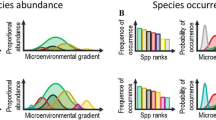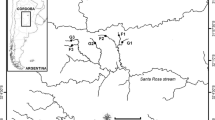Abstract
Habitat complexity plays a significant role in biological communities, but its effect on periphyton is still poorly understood. For example, the response of periphyton to changes in habitat relative to colonization time remains to be elucidated. Our hypothesis was that habitat complexity positively affects periphyton biomass, algal diversity, and change in species composition, while the response of periphyton to habitat complexity depends on colonization time. To test this hypothesis, we evaluated periphyton on artificial substrate distinct levels of habitat complexity at the intermediate (15 days) and advanced phases of colonization (30 days). Biomass, species richness, and diversity increased with level of structural complexity, but these attributes present significant difference only at the 15th day of colonization. In contrast, species composition changed with the increase of fractal dimension at both colonization times. Algal community response to distinct levels of structural habitat complexity was most significant at the 15th day of colonization. Our results showed that biomass, adaptive strategies groups, and taxonomic structure in periphyton were affected by habitat complexity, but that response was dependent on colonization time. Therefore, we concluded that colonization time is a factor that should be considered in assessing the effects of habitat complexity on periphyton.







Similar content being viewed by others
References
Allison, D. G., 2003. The biofilm matrix biofouling. School of Pharmacy and Pharmaceutical Sciences 19: 139–150.
Algarte, V. M., L. Rodrigues, V. L. Landeiro, T. Siqueira & L. M. Bini, 2014. Variance partitioning of deconstructed periphyton communities: does the use of biological traits matter? Hydrobiologia 722(1): 279–290.
Bicudo, C. E. M., C. F. Carmo, D. C. Bicudo, R. Henry, A. C. S. Pião, C. M. Santos & M. R. M. Lopes, 2002. Morfologia e morfometria de três reservatórios do PEFI. In Bicudo, D. C., M. C. Forti & C.E.M. Bicudo (orgs), Parque Estadual das Fontes do Ipiranga: unidade de conservação ameaçada pela urbanização de São Paulo. Secretaria do Meio Ambiente do Estado de São Paulo, São Paulo: 143–160.
Biggs, B. J. F., 1996. Patterns in benthic algae of streams. In Stevenson, R. J., M. L. Bothwell & R. L. Lowe (eds), Algal ecology: freshwater benthic ecosystems. Academic Press, San Diego: 31–51.
Burkholder, J. M., 1996. Interactions of benthic algae with their substrata. In Stevenson, R. J., M. L. Bothwell & R. L. Lowe (eds), Algal ecology: freshwater benthic ecosystems. Academic Press, San Diego: 253–297.
Brothers, S. M., S. Hilt, S. Meyer & J. Köhler, 2013. Plant community structure determines primary productivity in shallow, eutrophic lakes. Freshwater Biology 58(11): 2264–2276.
Casartelli, M. R., G. J. Lavagnolli & C. Ferragut, 2016. Periphyton biomass accrual rate changes over the colonization process in a shallow mesotrophic reservoir. Acta Limnologica Brasiliensia 28: e9.
Connell, J. H. & R. O. Slatyer, 1977. Mechanisms of succession in natural communities and their role in community stability and organization. American Naturalist 111: 1119–1144.
Cottingham, K. L. & S. R. Carpenter, 1998. Population, community, and ecosystem variates as, ecological indicators: phytoplankton responses to whole-lake enrichment. Ecological Applications 8: 508–530.
Dibble, E. D. & S. M. Thomaz, 2009. Use of fractal dimension to assess habitat complexity and its influence on dominant invertebrates inhabiting tropical and temperate macrophytes. Journal of Freshwater Ecology 24: 93–102.
Downes, B. J., P. S. Lake, E. S. G. Schreiber & A. Glaister, 2000. Habitat structure, resources and diversity: the separate effects of surface roughness and macroalgae on stream invertebrates. Oecologia 123(4): 569–581.
Ferragut, C. & D. C. Bicudo, 2010. Periphytic algal community adaptive strategies in N and P enriched experiments in a tropical oligotrophic reservoir. Hydrobiologia 646: 295–309.
Ferreiro, N., A. Giorgi & C. Feijoó, 2014. Effects of macrophyte architecture and leaf shape complexity on structural parameters of the epiphytic algal community in a Pampean stream. Aquatic Ecology 47: 389–401.
Fonseca, B. M., C. Ferragut, A. Tucci, L. O. Crossetti, F. Ferrari, D. C. Bicudo, C. L. Sant’Anna & C. E. M. Bicudo, 2014. Biovolume de cianobactérias e algas de reservatórios tropicais do Brasil com diferentes estados tróficos. Hoehnea 41: 9–30.
Goldsborough, L. G. & G. G. C. Robinson, 1996. Pattern in wetlands. In Stevenson, R. J., M. L. Bothwell & R. L. Lowe (eds), Algal ecology: freshwater benthic ecosystems. Academic Press, San Diego: 77–117.
Golterman, H. L., R. S. Clymo & M. A. M. Ohmstad, 1978. Methods for physical and chemical analysis of freshwaters. Blackwell Scientific Publications, Oxford.
Hammer, O., D. A. T. Harper & P. D. Ryan, 2001. PAST: paleontological statistics software package for education and data analysis. Palaeontologia Electronica 4: 1–9.
Hillebrand, H. & U. Sommer, 2000. Diversity of benthic microalgae in response to colonization time and eutrophication. Aquatic Botany 67(3): 221–236.
Hillebrand, H., C. D. Durselen, D. Kirschtel, U. Pollingher & T. Zohary, 1999. Biovolume calculation for pelagic and benthic microalgae. Journal of Phycology 35: 403–424.
Jones, J. I., B. Moss, J. W. Eaton & J. O. Young, 2000. Do submerged aquatic plants influence periphyton community composition for the benefit of invertebrate mutualists? Freshwater Biology 43: 591–604.
Kovalenko, K. E., S. M. Thomaz & D. M. Warfe, 2012. Habitat complexity: approaches and future directions. Hydrobiologia 685: 1–17.
Lund, J. W. G., C. Kipling & E. D. Le-Cren, 1958. The inverted microscope method of estimating algal number and the statistical basis of estimating by counting. Hydrobiologia 11: 143–170.
Mackereth, F. J. H., J. Heron & J. F. Talling, 1978. Water analysis: some revised methods for limnologists. Titus Wilson & Son Ltda, Kendall.
Magurran, A. E., 2004. Measuring biological diversity. Blackwell Science, Oxford.
Meerhoff, M., C. Iglesias, F. T. De Mello, J. M. Clemente, E. Jensen, T. L. Lauridsen & E. Jeppesen, 2007. Effects of habitat complexity on community structure and predator avoidance behaviour of littoral zooplankton in temperate versus subtropical shallow lakes. Freshwater Biology 52: 1009–1021.
Mormul, R. P., S. M. Thomaz, A. M. Takeda & R. D. Behrend, 2011. Structural complexity and distance from source habitat determine invertebrate abundance and diversity. Biotropica 43: 738–745.
Rangel, L. M., M. C. S. Soares, R. Paiva & L. H. S. Silva, 2016. Morphology-based functional groups as effective indicators of phytoplankton dynamics in a tropical cyanobacteria-dominated transitional river–reservoir system. Ecological Indicators 64: 217–227.
Rasband, W., 2008. ImageJ. U.S. National Institutes of Health, Bethesda, Maryland. http://rsb.info.nih.gov/ij/.
Roeselers, G., M. C. M. van Loosdrecht & G. Muyzer, 2008. Phototrophic biofilms and their potential applications. Journal of Applied Phycology 20: 227–235.
Salmaso, N. & J. Padisák, 2007. Morpho-functional groups and phytoplankton development in two deep lakes (Lake Garda, Italy and Lake Stechlin, Germany). Hydrobiologia 578(1): 97–112.
Santos, T. R., C. Ferragut & C. E. M. Bicudo, 2013. Does macrophyte architecture influence periphyton? Relationships among Utricularia foliosa, periphyton assemblage structure and its nutrient (C, N, P) status. Hidrobiologia 714: 71–83.
Saravia, L. A., A. Giorgi & F. Momo, 2012. Multifractal spatial patterns and diversity in an ecological succession. PLoS ONE 7: e34096.
Sartory, D. P. & J. U. Grobbelaar, 1984. Extraction of chlorophyll-a from freshwater phytoplankton for spectrophotometric analysis. Hydrobiologia 114: 177–187.
Solorzano, L., 1969. Determination of ammonia in natural waters by the phenolhypochlorite method. Limnology and Oceanography 14: 799–801.
Strickland, J. D. H. & T. R. Parsons, 1960. A manual of seawater analysis. Bulletin Fisheries Research Board of Canada 125: 1–185.
Sugihara, G. & R. May, 1990. Application of fractals in ecology. Trends in Ecology & Evolution 5: 79–86.
Taniguchi, H., S. Nakano & M. Tokeshi, 2003. Influences of habitat complexity on the diversity and abundance of epiphytic invertebrates on plants. Freshwater Biology 48: 718–728.
Thomaz, S. M., E. D. Dibble, L. R. Evangelista, J. Higuti & L. M. Bini, 2008. Influence of aquatic macrophyte habitat complexity on invertebrate abundance and richness in tropical lagoons. Freshwater Biology 53: 358–367.
Tonetto, A. F., R. Cardoso-Leite, C. K. Peres, P. C. Bispo & C. C. Z. Branco, 2014. The effects of habitat complexity and hydraulic conditions on the establishment of benthic stream macroalgae. Freshwater Biology 59: 1687–1694.
Tokeshi, M. & S. Arakaki, 2012. Habitat complexity in aquatic systems: fractals and beyond. Hydrobiologia 685: 27–47.
Utermöhl, H., 1958. Zur Vervolkomnung der quantitative phytoplankton: metodik. Internationale Vereinigung Theoretische und Angewandte Limnologie 9: 1–38.
Valderrama, G. C., 1981. The simultaneous analysis of total nitrogen and total phosphorus in natural waters. Marine Chemistry 10: 109–112.
Acknowledgements
MRC thanks FAPESP (Fundação de Amparo a Pesquisa do Estado de São Paulo, Grant No. 2012/07366-8) for the Master of Science fellowship, and CF is grateful for the financial support (Grant No. 2009/52253-4). The authors are also grateful to all the students and technicians involved in the laboratory and fieldwork.
Author information
Authors and Affiliations
Corresponding author
Additional information
Handling editor: Judit Padisák
Rights and permissions
About this article
Cite this article
Casartelli, M.R., Ferragut, C. The effects of habitat complexity on periphyton biomass accumulation and taxonomic structure during colonization. Hydrobiologia 807, 233–246 (2018). https://doi.org/10.1007/s10750-017-3396-8
Received:
Revised:
Accepted:
Published:
Issue Date:
DOI: https://doi.org/10.1007/s10750-017-3396-8




